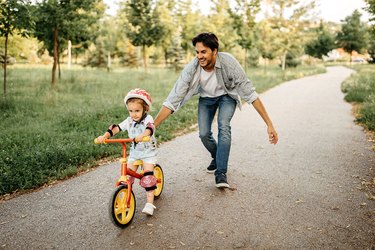
Whether your kids are using their bikes to cruise to the park on the weekends or for daily transportation to school, the right fit means they'll be ready to ride safely. Among the adjustments you'll need to make is ensuring the proper bike seat height.
Kids tend to need their seats adjusted slightly lower than adults so they can touch one or both feet to the ground; sometimes less-than-agile bodies need a little extra stability.
Video of the Day
Video of the Day
Here are some tips for adjusting your child's bike seat height.
Choosing a Bike Size
Part of getting the right fit for your child's bike -— and thus the proper seat height -— is ensuring they're riding a bike that's the right size for them overall.
Keep in mind that children's bikes are measured by wheel size and not their frame, according to REI. The most common children's bike sizes are 16 inches, 20 inches and 24 inches. The right-sized bike is one where both of your child's feet are on the ground when standing, and their legs are slightly bent at the bottom of a pedal stroke when riding.
Before you start to make seat adjustments, have your child stand over the frame of the bike while wearing the shoes they plan to have on while riding.
For road bikes, there should be about 1 inch of clearance between their body and the top tube — the horizontal or angled tube that stretches between the seat post and the handlebar stem. For mountain bikes, there should be more like 3 to 4 inches.
If they have the angled top tube, which is common among girls' bikes, the space will also be 2 inches or more, but have them stand as close to the handlebars as possible to ensure there's at least 1 inch of clearance. If their pubic bone is hitting the tube, the bike is not the right size. Your child should be able to straddle the bike without their crotch hitting the top tube of the bike, according to REI.
You also want to make sure that your child can comfortably reach for the handlebars when seated. There should be a slight bend in their elbows and be able to steer the bike and squeeze the brakes easily, per REI.
Adjusting a Child's Bike Seat Checklist
- Top Tube Height: There should be about 1 inch of clearance between their body and the top tube on road bikes. For mountain bikes, there should be 3 to 4 inches. Kids should be able to straddle the bike without their crotch hitting the top tube.
- Handlebars: Make sure your child is able to comfortably reach for the handlebars and easily steer and squeeze the hand brakes.
- Pedals: Your child's leg should be slightly bent at the bottom of a pedal stroke and be able to put at least one or both feet on the ground while seated.
Feet On the Pedals
When you're sure that your child's bike is the right overall frame size, it's time to adjust the seat to an appropriate height. Hold onto the frame and handlebars and instruct your child to get onto the seat and place their feet on the pedals.
Have them press forward on the pedals until one pedal is all the way to the bottom of the pedal stroke. At this bottom position, their leg should be ever so slightly bent. At the bottom of the stroke, your child shouldn't have to point their toes to keep touching the pedals — that's a sure sign the seat is too high.
Feet On the Ground
Next, ask your child to put at least one foot on the ground while remaining in the saddle. They should be able to get one foot on the ground while still staying seated.
If they're a total beginner to cycling, it may be safer to have the seat adjusted to a height that allows them to touch both feet on the ground. That way, they can kick their feet to propel the bike as they're learning how to pedal and stay upright. They can also plant both feet on the ground if they need to make an emergency stop.
A Comfortable Bike Seat
When you're adjusting your child's bike seat to the proper height — either with a wrench or using the quick-release lever supplied on many kids' bikes — take their personal comfort into account as well. Bike experts may have their recommendations for how high your child's seat should be, but that doesn't mean your child is going to be happy with those guidelines.
Kids tend to like their seats lower than is recommended, so you may have to make a compromise. A seat that is lower than it should be is preferable to a seat that's too high since your child will be able to reach her feet to the ground easily.
So long as they're able to control the bike and the gears, allow them to ride at their comfort level. Over time though, you may encourage them to raise the seat to the recommended height. Explain to your child that too low of a seat can cause pain in their knees and make it more difficult to pedal efficiently.